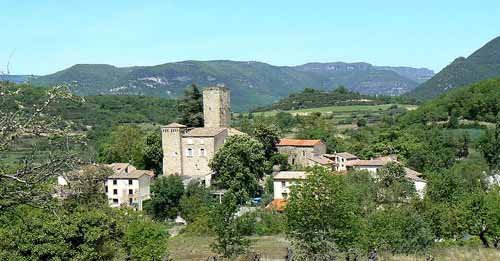Wednesday, 9 June 2004
Distance 21 km
Duration 4 hours 30 minutes
Ascent 262 m, descent 721 m
Map 65 of the TOP100 blue series (now superseded)
Topoguide (ref 716) Traversée du Haut-Languedoc – GR7, GR71

As arranged with our hostess, we crept out through the restaurant at the back, although we were only five minutes ahead of the opening time of 8 o’clock, having slept in slightly in the unusual comfort. Straight away we had to climb the ridge behind the town, a stiff pull of 300 metres or so.
After that the way was at first in open grassland, on a level road of white stones, with wildflowers crowding the edges, and then amongst pines. There were other GRs dropping off on either side, including a variant of the pilgrim Way of Arles, but we continued along the ridge.
In the midst of this isolation we noticed a wierd expanse of roofing, which proved to be the premises of an architectural firm. We looked around but nobody had arrived at work yet.

A bit further on we came to the place where the GR departed from the forestry road, so we sat down and had an early lunch consisting of the left-over goat chop from last night, some cheese and a piece of rock-hard old bread. There was a pleasant view through the trees of the valley of the Lergue.
Then we were dropping through the pines on the sort of track that makes Keith wake in fright, but he managed very well.
At the bottom we joined a local road lined with vines and a cherry orchard, where we rounded off our lunch in fine style. As if to punish us for this casual thievery, the track degenerated into a rough, overgrown lane that filled our socks with seeds.

However after Fozières, a place with no facilities (being so close to Lodève), things improved greatly. The GR became a shady path beside a stream leading to the underpass of the massive new autoroute. It was a brilliant piece of local knowledge.
From there we followed the flanking road briefly, then crossed the river and entered Lodève. The Rue de la République passed through the usual dingy outskirts but eventually we made it, hot and thirsty, to the centre.
Bars, brasseries, and restaurants of all kinds lined the streets, and the people who thronged about seemed to be either lily-white English tourists or North Africans. Why either group was represented in such numbers we were not able to find out.

At the bar where we had our coffee, a man from Yorkshire thought it very unfair that my pack was so much bigger than Keith’s. I agreed with him, omitting to mention that my bedroll, light as a feather, took up most of the space in mine.
When the Office of Tourism opened at 2:30, we put our boots back on and went to find out about camping grounds. The nearest one was 5 km downstream at Soubès, so once again our tent and sleeping bags would remain rolled up for the night.
There were three hotels to choose from and after a preliminary stroll we chose a large old establishment just across the bridge, la Croix Blanche.

A simple room with a washstand was €26, but the woman on the desk, grim-faced and with a body like a filing cabinet, warned us that the only shower was across the courtyard and up a flight of stairs. We did not care. It was all luxurious to us, and when we had washed ourselves and our clothes, we slept blissfully for the rest of the afternoon.
As the heat declined we ventured out to send an email, admire the cathedral and wander around the back streets, which were full of North Africans.
The choice of eating places was surprisingly small and we ended up in the dining room of our hotel, whose dark panelling, white napery and bevel-edged glass we had glimpsed on the way in. Old hotels are usually very good places for a meal and this one certainly was.
We had crudités, escaloppes, then crème brûlée and white cheese with strawberry sauce. Instead of a carafe of wine we had a bottle of Languedoc red.
In our divinely comfortable room we fell asleep with the excited babble of a group of English guests floating up from the terrace below.
Previous day: Navacelles to la Vacquerie-et-St-Martin-de-Castries